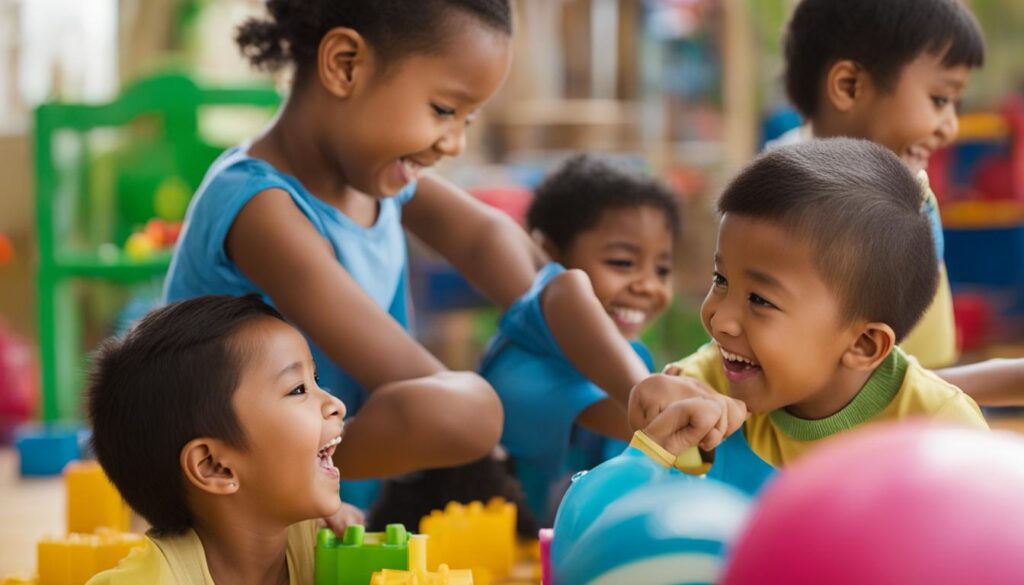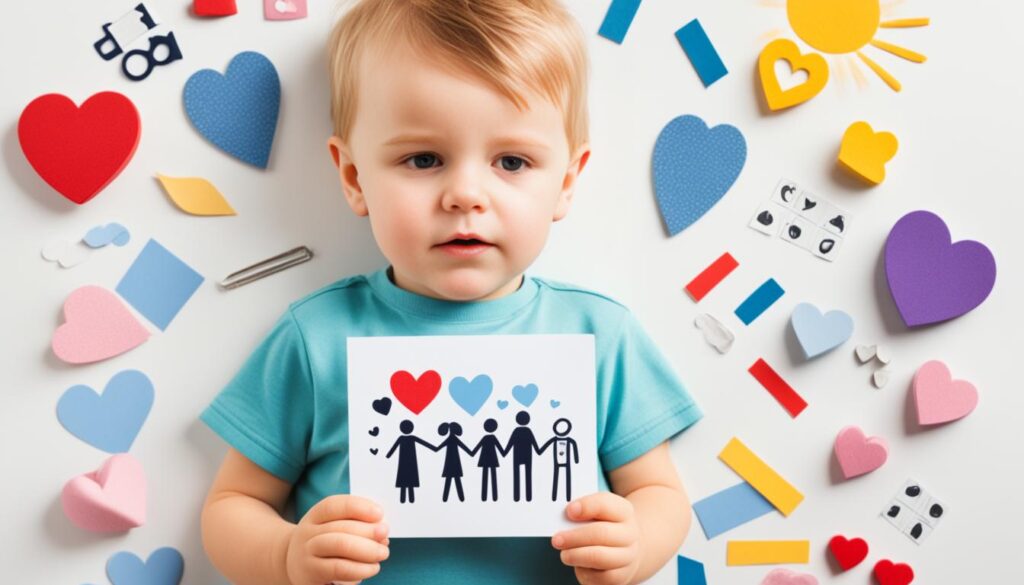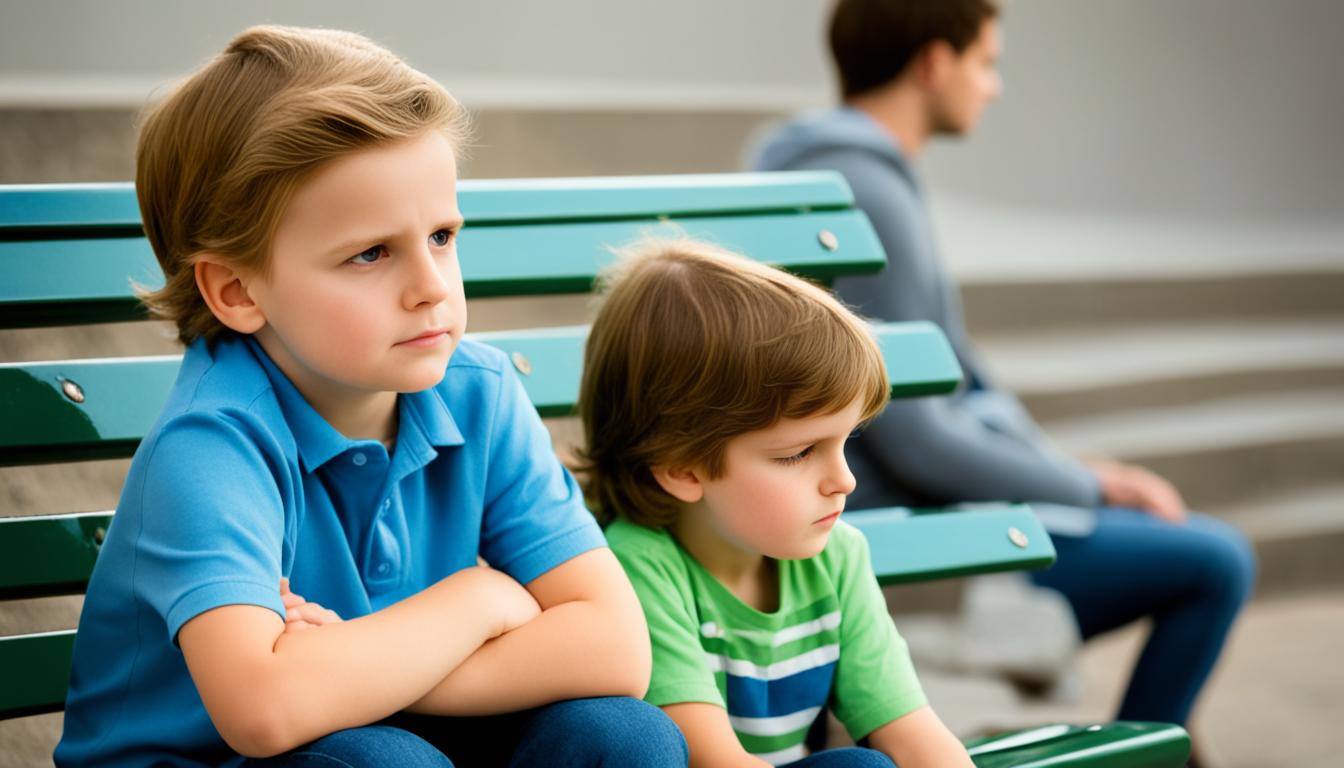Did you know that approximately 40-50% of marriages in the United States end in divorce? While deciding to divorce is never easy, it can greatly impact children in lasting ways.
When going through a divorce, it’s crucial to prioritize the well-being of your children and approach the process with empathy and compassion. Adopting a child-centered divorce approach can help minimize the trauma and emotional upheaval typically associated with divorce. This approach focuses on introspection, emotional balance, and alternatives to conventional court litigation, paving the way for a more amicable and supportive transition for everyone involved.
In this comprehensive guide, we will explore the importance of introspection in divorce, strategies for managing emotions and avoiding conflict, embracing alternatives to court litigation, and strategies for creating a child-centered divorce. By prioritizing the well-being of your children and adopting a child-centered approach, you can facilitate a smoother transition and ensure a healthier environment for everyone involved.
Key Takeaways:
- Divorce is a common occurrence in the United States, affecting a significant number of families.
- A child-centered divorce approach prioritizes the well-being of children and aims to minimize trauma.
- Introspection and emotional balance are crucial in fostering an amicable divorce.
- Effective communication, cooperation, and alternatives to court litigation can help reduce conflict.
- Creating new traditions and providing emotional support are key strategies for supporting children through divorce.
Understanding the Importance of Introspection in Divorce
When a marriage comes to an end, it’s natural for individuals to search for someone to blame. However, assigning blame often leads to unnecessary drama and bitterness. In order to foster an amicable divorce, it is crucial to recognize that both partners play a role in the dissolution of the marriage. This understanding sets the stage for a more empathetic and compassionate approach to the divorce process.
One key aspect of fostering this empathetic mindset is introspection. Self-awareness plays a significant role in reducing conflict and creating a more peaceful divorce experience. By taking the time to reflect on one’s own actions and contributions to the end of the marriage, individuals can approach the divorce process with a greater level of compassion and understanding. This introspective approach allows for a more amicable resolution, without exacerbating tensions or creating unnecessary drama.
“By understanding and acknowledging their own role in the marriage’s end, individuals can bring a sense of self-awareness to the table. This self-awareness leads to a more constructive and empathetic approach, reducing conflict and promoting a healthier divorce process.”
Introspection also helps individuals let go of any resentments or grudges they may hold towards their partner. It allows them to focus on finding fair and equitable solutions that prioritize the well-being of both parties involved. By embracing introspection, individuals can cultivate a mindset that is centered on finding common ground and reducing conflict, rather than perpetuating animosity and hostility.
Overall, understanding the importance of introspection in divorce is crucial for promoting an amicable resolution. By recognizing one’s own role in the marriage’s end and fostering self-awareness, individuals can approach the divorce process with empathy and understanding. This mindset significantly reduces conflict and contributes to a more peaceful and respectful divorce experience.

Key Takeaways:
- Assigning blame in divorce leads to unnecessary drama and bitterness.
- Recognizing both partners’ contributions to the end of the marriage fosters a more amicable divorce.
- Introspection plays a significant role in reducing conflict and promoting empathy.
- Self-awareness allows individuals to approach the divorce process with compassion and understanding.
- Letting go of resentments and focusing on finding fair solutions prioritizes the well-being of both parties involved.
Managing Emotions and Avoiding Conflict
Divorce is a challenging and emotionally charged process for all parties involved. Emotions tend to run high during divorce proceedings, and it is essential to manage them effectively to avoid unnecessary conflict and hostility. By prioritizing emotional balance, problem-solving, and constructive communication, individuals can create a more peaceful and amicable environment throughout the divorce process.
One of the key elements in managing emotions during divorce is maintaining emotional balance. It is natural to feel a wide range of emotions such as anger, sadness, and resentment, but reacting impulsively can escalate the situation. By taking the time to acknowledge and process these emotions, individuals can respond thoughtfully and avoid destructive confrontations that hinder progress.

Problem-solving is another crucial aspect of navigating a divorce without unnecessary drama. By adopting a problem-solving mindset, individuals can focus on finding constructive solutions rather than getting caught up in conflicts that prolong the process. Engaging in mediation or collaborative divorce can facilitate a problem-solving approach and provide a space for open dialogue and compromise.
Constructive communication is fundamental to reducing hostility during divorce. By fostering open and effective communication, individuals can express their needs, concerns, and expectations in a respectful manner. This creates an environment where conflicts can be resolved amicably and ensures that everyone’s perspectives are considered.
Reducing hostility benefits not only the individuals going through the divorce but also any children involved. Children are highly susceptible to the emotional climate surrounding their parents’ divorce and can be negatively affected by ongoing conflict. By maintaining a peaceful atmosphere, parents can protect their children’s emotional well-being and provide them with a stable environment to thrive in.
Fostering Constructive Communication
To effectively reduce hostility and foster constructive communication, individuals can implement the following strategies:
- Active listening: Paying attention to the other person’s perspective and validating their feelings.
- Using “I” statements: Expressing feelings and needs without blaming or accusing the other party.
- Seeking professional help: Enlisting the assistance of mediators or therapists who specialize in helping couples navigate communication challenges.
- Setting boundaries: Clearly defining acceptable and unacceptable behavior during interactions.
| Benefit of Constructive Communication | Explanation |
|---|---|
| Reduces conflict | Effective communication helps prevent misunderstandings and escalations, reducing the likelihood of conflicts. |
| Promotes understanding | By actively listening and expressing needs, individuals can gain a better understanding of each other’s perspectives, fostering empathy and cooperation. |
| Facilitates problem-solving | Constructive communication enables couples to engage in productive discussions, leading to mutually beneficial solutions. |
By prioritizing emotional balance, problem-solving, and constructive communication, individuals can navigate the divorce process with greater ease and reduce unnecessary drama and conflict. This approach not only benefits the individuals involved but also creates a healthier environment for any children affected by the divorce.
Embracing Alternatives to Conventional Litigation
Minimizing divorce-related drama involves avoiding the adversarial nature of the court system. Approaches like mediation or collaborative divorce prioritize cooperation, problem-solving, and open communication. By embracing these alternatives, individuals can significantly reduce drama, preserve financial resources, and expedite the resolution process. These methods encourage compromise and allow for a more amicable divorce process.
In mediation, a neutral third-party mediator assists the couple in reaching a mutually agreeable settlement. This collaborative approach fosters open dialogue and empowers both parties to make informed decisions about their future. Mediation provides a less formal, more flexible environment, allowing couples to work through disputes and devise creative solutions. With the mediator’s guidance, couples can navigate potential roadblocks while maintaining control over the outcomes.
Collaborative divorce, on the other hand, involves a team-based approach that includes attorneys, therapists, financial advisors, and other professionals. The emphasis is on cooperation and problem-solving, rather than pitting one spouse against the other. This collaborative effort helps couples prioritize the well-being of their children and work towards a fair and mutually acceptable resolution. With open communication and a shared commitment to finding solutions, collaborative divorce can often result in more customized and satisfactory outcomes for all involved.
By choosing alternatives to court litigation, individuals can minimize conflict, reduce stress, and expedite the divorce process. Mediation and collaborative divorce provide a platform for constructive discussions, fostering a cooperative environment. Rather than relying on a judge to make decisions, couples can actively participate in shaping the outcome of their divorce. This level of involvement increases satisfaction and preserves important relationships, which is especially crucial when co-parenting responsibilities are involved.
Mediation vs. Collaborative Divorce: A Comparison
| Mediation | Collaborative Divorce |
|---|---|
| Mutually agreeable settlement reached with the help of a mediator | Team-based approach involving attorneys, therapists, and financial advisors |
| Fosters open communication and creative problem-solving | Emphasizes cooperation and shared commitment to finding solutions |
| Less formal, flexible environment for working through disputes | Allows for more customized and satisfactory outcomes |
| Increases control over the divorce process | Preserves important relationships, particularly in co-parenting situations |
Mediation and collaborative divorce offer alternatives to the traditional court process, allowing couples to resolve their differences in a more amicable and efficient manner. By embracing these approaches, individuals can reduce stress, preserve financial resources, and prioritize cooperative decision-making.

Acknowledging When Litigation May be Necessary
While alternative methods like mediation or collaborative divorce are beneficial, it’s important to acknowledge that not every case can entirely avoid litigation. In some instances, court intervention may be necessary.
However, adopting a problem-solving mindset can lead to more amicable solutions, preventing an extended period of litigation. By prioritizing efficient issue resolution and focusing on amicability, individuals can navigate the court system with a more positive approach.
“The ultimate objective is to find common ground and reach a resolution that is in the best interest of all parties involved.”
The Importance of Prioritizing Amicability
When litigation becomes necessary, maintaining a problem-solving mindset can significantly impact the outcome of the case. By embracing a cooperative and amicable approach, individuals can avoid unnecessary conflicts and animosity, reducing the negative impact on emotional well-being.
By working towards amicable solutions, individuals can protect their own interests while also considering the needs of the other party. This mindset promotes open communication, compromise, and finding common ground, fostering a more positive environment during the litigation process.
Minimizing Conflict through Mediation
One alternative to traditional litigation is mediation, which can help parties find mutually agreeable solutions with the help of a neutral third-party mediator. Mediation promotes effective communication and collaboration, allowing individuals to express their concerns and work towards finding common ground.
This approach offers several advantages, including a more efficient and cost-effective process, greater control over the decision-making process, and the opportunity to develop creative solutions that meet the unique needs of both parties.
Utilizing Collaborative Divorce for Amicable Resolution
Another viable option is collaborative divorce, a process that encourages both parties and their respective attorneys to commit to resolving the issues outside of court. This approach prioritizes cooperation, problem-solving, and open communication.
In a collaborative divorce, the parties work together in a series of meetings to reach mutually beneficial agreements. This process can help preserve long-term relationships, particularly when children are involved, as it promotes a more cooperative and respectful approach.
The Impact of Divorce on Children
Divorce can have a profound emotional and psychological impact on children, making it a particularly challenging experience for them. It is crucial for parents to prioritize their children’s well-being and provide them with the necessary support and understanding during this transition. By adopting a child-centered divorce approach, parents can minimize the negative effects of divorce and create a supportive environment for their children.
During a divorce, children often experience a range of emotions, including sadness, confusion, anger, and anxiety. These emotions can disrupt their daily lives and affect their overall well-being. It is essential for parents to offer emotional support, reassurance, and patience as children navigate their feelings and adjust to the changes in their family dynamics.
A child-centered divorce approach recognizes the importance of considering children’s needs throughout the process. It involves open communication between parents and children, helping them express their feelings, concerns, and questions. By actively involving children in decision-making, parents empower them and help them feel heard and understood. This involvement can contribute to their overall emotional resilience and provide a sense of security during a challenging period.
Creating a stable and predictable environment is crucial for children’s emotional well-being during and after a divorce. Maintaining consistent routines and establishing new traditions can help provide a sense of continuity and familiarity. Giving children a sense of stability can alleviate anxiety and promote a healthier adjustment to the changes in their family structure.
Professional help, such as therapy or counseling, can also be beneficial for children going through a divorce. Trained professionals can provide a safe space for children to express their emotions, help them develop healthy coping mechanisms, and assist them in navigating the complex emotions they may be experiencing.
By prioritizing children’s well-being and considering the emotional and psychological impact of divorce, parents can make a significant difference in their children’s lives. A child-centered divorce approach creates an environment that fosters growth, resilience, and emotional support, ultimately helping children navigate the challenges of divorce more effectively.
Statistics on the Emotional and Psychological Impact of Divorce on Children:
| Statistic | Findings |
|---|---|
| Increased risk of mental health issues | Children of divorced parents are more likely to experience depression, anxiety, and behavioral problems. |
| Academic challenges | Divorce can negatively affect children’s academic performance and overall educational attainment. |
| Emotional instability | Children may exhibit emotional instability and struggle with unresolved feelings related to the divorce. |
| Higher likelihood of future relationship difficulties | Children of divorced parents may face challenges in forming and maintaining healthy relationships in adulthood. |

Strategies for a Child-Centered Divorce
When going through a divorce, prioritizing the well-being of your children is of utmost importance. By implementing specific strategies aimed at open communication, co-parenting cooperation, emotional support, stability and routine, as well as the involvement of children, you can ensure a child-centered divorce that minimizes the impact on their lives.
1. Open Communication
Creating an open and honest dialogue with your children is vital during a divorce. Encourage them to express their feelings, concerns, and questions. Provide a safe space for them to discuss their emotions and reassure them that their voices are being heard.
2. Co-Parenting Cooperation
Prioritize a cooperative co-parenting approach with your ex-partner. Collaborate on important decisions regarding your children’s well-being, education, and healthcare. Maintain consistency and avoid conflicting rules or expectations between households to provide a supportive and nurturing environment for your children.
3. Emotional Support
Divorce can be emotionally challenging for children. Offer them emotional support throughout the process by being a stable and empathetic presence in their lives. Validate their feelings and provide reassurance that they are loved and supported unconditionally.
4. Stability and Routine
Children thrive on stability and routine, especially during times of change. Establish consistency by maintaining regular routines and schedules. This sense of stability will help them feel secure and adjust more smoothly to the new family dynamic.
5. Involvement of Children
Involve your children in decision-making processes that directly impact their lives. Seek their input on matters that are age-appropriate, such as visitation schedules or shared custody agreements. By involving them in the process, they gain a sense of empowerment and feel their opinions are valued.
“A child-centered divorce is all about putting the needs of children first. By prioritizing open communication, cooperation in co-parenting, emotional support, stability, routine, and involving children in decision-making, parents can ensure a smoother transition for their children.
By implementing these strategies, you can create a child-centered divorce that focuses on the well-being and happiness of your children. Remember, the more open and supportive the environment, the better they will be able to navigate the changes brought about by divorce.

Creating New Traditions and Rituals
As families adapt to the changes brought about by divorce, it’s essential to establish new traditions and rituals that promote continuity and support. These customs play a vital role in helping children navigate the transition and maintain a sense of stability and belonging.
One way to create new traditions is by celebrating milestones such as birthdays and holidays. These special occasions provide an opportunity for family members to come together and show their love and affection for one another. Through these celebrations, children can feel connected to their family, even in the midst of changes.
These newly established traditions also help children maintain a sense of normalcy, despite the alterations in their family structure. By participating in these activities and rituals, children can find comfort and familiar routines that contribute to their overall well-being.

Creating new traditions and rituals after divorce has a profound impact on the family’s dynamics. These meaningful experiences foster a sense of togetherness, support, and continuity, reaffirming that family bonds remain strong regardless of the changes taking place.
Providing Emotional Support for Children
During divorce, children go through a rollercoaster of emotions, and it’s essential for parents to step in and offer them the emotional support they need. By being attentive to their children’s emotional needs and providing a compassionate and supportive presence, parents can help their children navigate this challenging time with more resilience and stability.
However, there may be instances where children require professional help to process their emotions and develop healthy coping mechanisms. Seeking therapy or counseling can provide children with a safe space to express themselves and learn effective strategies for managing their emotions during divorce.
Emotional support plays a crucial role in helping children navigate the challenges that come with divorce. It helps them develop a stronger sense of self-awareness and equips them with the tools to handle their emotions in a healthy way. By addressing their emotional needs, parents create an environment that fosters healing and growth, allowing children to thrive.
“Emotional support plays a vital role in helping children navigate the challenges of divorce, providing them with a safe space to express themselves and develop healthy coping mechanisms.”
The Benefits of Professional Help
When parents seek professional help for their children during divorce, they give them access to specialized guidance and support. Therapists or counselors trained in child psychology can provide valuable insights and strategies tailored to each child’s unique emotional needs.
Professional help allows children to:
- Gain a better understanding of their emotions: Therapists can help children identify and label their emotions, enabling them to express themselves more effectively.
- Develop healthy coping mechanisms: Through therapy, children can learn new coping strategies that promote emotional resilience and well-being.
- Explore their thoughts and feelings: Talking with a professional can help children process their thoughts and emotions in a safe and non-judgmental environment.
- Receive validation and support: Professionals provide validation, reassurance, and guidance, helping children feel heard and understood.
A Holistic Approach to Emotional Support
Parents should also foster emotional support at home, creating a nurturing environment that encourages open communication and validation. Here are some important steps parents can take:
- Encourage expression of emotions: Allow children to express their feelings without judgment, creating a safe space for them to share their thoughts and concerns.
- Listen actively: Practice active listening to show children that their emotions are valued, creating a sense of validation and trust.
- Provide reassurance: Assure children that their feelings are valid and that it’s okay to feel a wide range of emotions during this time.
- Offer stability and routine: Establishing consistent routines and predictable environments can help children feel secure and grounded.
- Involve children in decision-making: Including children in age-appropriate discussions about the divorce can help them feel empowered and build their resilience.
By providing emotional support, both through professional help and at home, parents can help their children develop healthy coping mechanisms and navigate the challenges of divorce with greater emotional well-being.

Conclusion
Adopting a child-centered divorce approach is paramount for safeguarding the well-being of children and ensuring a positive co-parenting dynamic. This approach prioritizes open communication, cooperation, emotional support, and stability, resulting in the empowerment of both parents and children alike.
By focusing on the unique needs of children during divorce proceedings, parents can foster emotional resilience and create an environment that supports their growth and development. Nurturing such resilience equips children with the tools to navigate the challenges they may encounter, promoting a positive outlook for their future.
A child-centered divorce approach lays the foundation for positive co-parenting relationships, allowing parents to work together effectively and communicate constructively. This collaboration facilitates a healthier and more supportive environment for children, ensuring they feel loved, secure, and heard.
FAQ
What is a child-centered divorce approach?
A child-centered divorce approach is a method that prioritizes the well-being of children during the divorce process. It focuses on minimizing the negative effects of divorce on children and creating a supportive environment for them.
How can introspection help in achieving an amicable divorce?
Introspection plays a significant role in achieving an amicable divorce by promoting self-awareness and empathy. By understanding one’s own role in the marriage’s end, individuals can approach the divorce process with more compassion and understanding.
How can emotional balance and constructive problem-solving reduce conflict during a divorce?
Prioritizing emotional balance and constructive problem-solving can help prevent unnecessary drama and conflict during a divorce. By fostering open and effective communication, individuals can reduce hostility and create an environment conducive to resolution.
What are the alternatives to conventional court litigation in a divorce?
Alternatives to conventional court litigation in a divorce include mediation and collaborative divorce. These methods prioritize cooperation, problem-solving, and open communication, reducing the adversarial nature of the court system.
When is court intervention necessary in a divorce?
While alternative methods are beneficial in many cases, court intervention may be necessary in some instances. However, adopting a problem-solving mindset can lead to more amicable solutions, preventing an extended period of litigation.
How does divorce impact children’s well-being?
Divorce can have a significant emotional and psychological impact on children’s well-being. It’s crucial for parents to prioritize their children’s needs and provide them with the necessary support and understanding during this transition.
What strategies can be used for a child-centered divorce?
Strategies for a child-centered divorce include open communication, co-parenting cooperation, emotional support, stability and routine, and involvement of children in decision-making. These strategies aim to create a supportive environment for children during and after the divorce.
How can creating new traditions and rituals help children during a divorce?
Creating new traditions and rituals can provide a sense of continuity and support for children during a divorce. Celebrating milestones and holidays helps children feel connected and loved, despite the changes in their family structure.
What can parents do to provide emotional support for their children during a divorce?
Parents can provide emotional support for their children during a divorce by being attentive to their emotional needs and offering a compassionate and supportive presence. Seeking professional help, such as therapy or counseling, can also provide children with the necessary tools to process their emotions.
What are the benefits of a child-centered divorce approach?
A child-centered divorce approach benefits children by promoting open communication, cooperation in co-parenting, emotional support, stability, and empowerment. It sets the foundation for positive co-parenting relationships and effective communication, ensuring a healthier and more supportive environment for children as they navigate the challenges of divorce.










